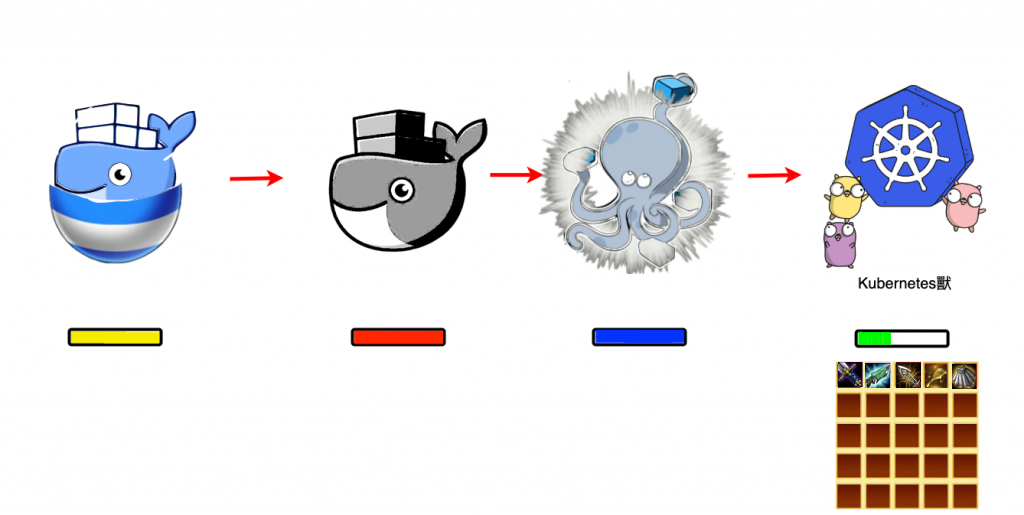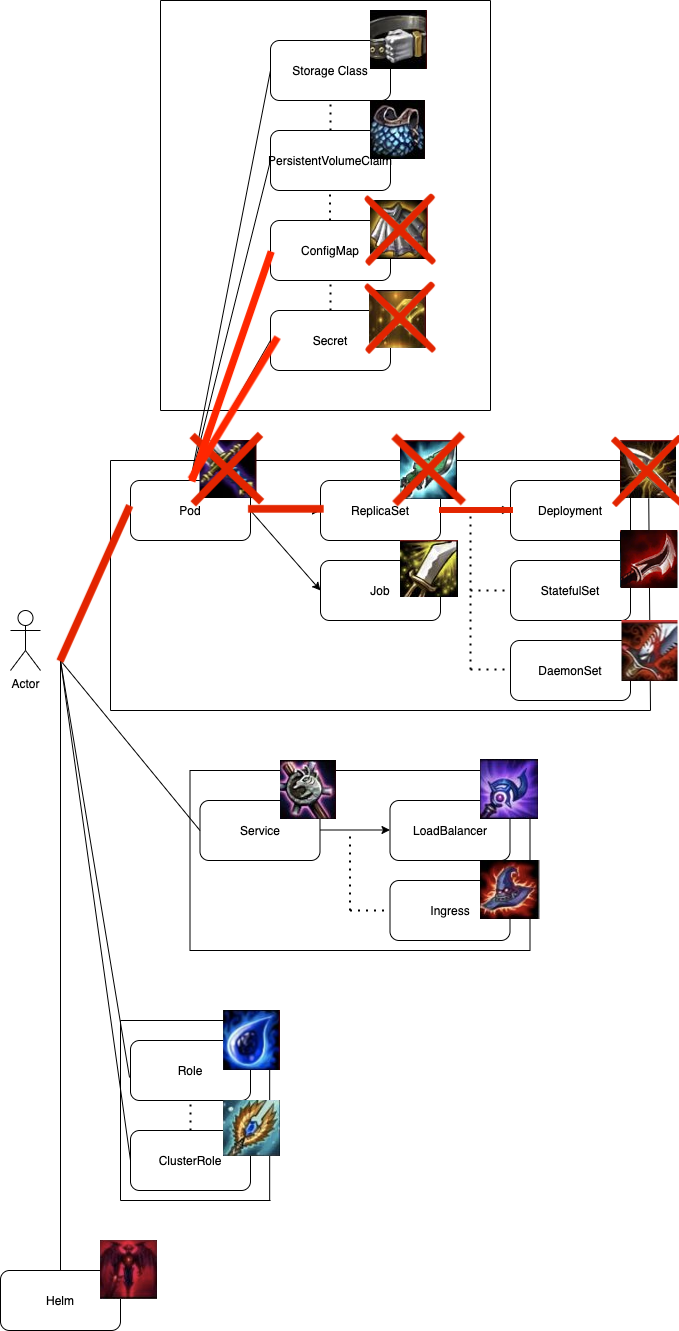還記得在Day-19 Pod, ReplicaSet and deployment(下)當中有講述到configMap與Secret嗎?
我們先召喚出deployment.yaml來喚醒大家的記憶,並告訴大家如何使用它
apiVersion: apps/v1
kind: Deployment
metadata:
name: ironman
labels:
name: ironman
app: ironman
spec:
minReadySeconds: 5
strategy:
type: RollingUpdate
rollingUpdate:
maxSurge: 1
maxUnavailable: 1
selector:
matchLabels:
app: ironman
replicas: 1
template:
metadata:
labels:
app: ironman
spec:
containers:
- name: ironman
image: ghjjhg567/ironman:latest
imagePullPolicy: Always
ports:
- containerPort: 8100
resources:
limits:
cpu: "1"
memory: "2Gi"
requests:
cpu: 500m
memory: 256Mi
envFrom:
- secretRef:
name: ironman-config
command: ["./docker-entrypoint.sh"]
- name: redis
image: redis:4.0
imagePullPolicy: Always
ports:
- containerPort: 6379
- name: nginx
image: nginx
imagePullPolicy: Always
ports:
- containerPort: 80
volumeMounts:
- mountPath: /etc/nginx/nginx.conf
name: nginx-conf-volume
subPath: nginx.conf
readOnly: true
- mountPath: /etc/nginx/conf.d/default.conf
subPath: default.conf
name: nginx-route-volume
readOnly: true
readinessProbe:
httpGet:
path: /v1/hc
port: 80
initialDelaySeconds: 5
periodSeconds: 10
volumes:
- name: nginx-conf-volume
configMap:
name: nginx-config
- name: nginx-route-volume
configMap:
name: nginx-route-volume
在上面yaml中的secretRef與configMap就是引用已經創建好的secret與configMap來做使用,那在本篇章我們會來解說configMap與secret,以及使用的原理與原因。
ConfigMap是一個API Object,主要用來將非機密性的資料儲存至Key-Value當中,使用時可以用作環境變量、命令行參數或者Volumes中的配置文件。
也因為ConfigMap是一個API Object,所以他的命名必須要符合DNS Subdomain Names。

使用ConfigMap好處是讓你的服務能與配置數據分離,舉例來說你有著test、uat與prod三個不同環境,只需要再這三個環境的pod中匯入不同的configMap即可完成配置。這也讓我們能更簡潔地進行容器化開發與測試。
我們這邊以repository的prd.env為例子
REDIS_HOST=redis
REDIS_PORT=6379
$ kubectl create configmap configmap-prd --from-literal=REDIS_HOST=redis --from-literal=REDIS_PORT=6379
configmap "configmap-prd" created
$ kubectl describe configmap configmap-prd
Name: configmap-prd
Namespace: default
Labels: <none>
Annotations: <none>
Data
====
REDIS_HOST:
----
redis
REDIS_PORT:
----
6379
Events: <none>
$ kubectl create configmap configmap-prdd --from-file=../prd.env
configmap/configmap-prdd created
$ kubectl describe configmap configmap-prdd
Name: configmap-prdd
Namespace: default
Labels: <none>
Annotations: <none>
Data
====
prd.env:
----
REDIS_HOST=redis
REDIS_PORT=6379
Events: <none>
兩者的差距就僅是在Data儲存的方式,一個是依照data的key-value儲存,另一種是更上層有個key為file名稱,下面的key-value才是儲存file內的資料。
在pod內container中的envFrom.configMapRef填入已經創建好的configMap。
template:
metadata:
labels:
app: ironman
spec:
containers:
- name: ironman
image: ghjjhg567/ironman:latest
imagePullPolicy: Always
ports:
- containerPort: 8100
resources:
limits:
cpu: "1"
memory: "2Gi"
requests:
cpu: 500m
memory: 256Mi
envFrom:
- configMapRef:
name: configmap-prd
這邊的話需要再volumes定義你在這pod中的volume並binding你的configMap,之後即可在pod中使用volumeMounts來將data mount進指定的container。
template:
metadata:
labels:
app: ironman
spec:
containers:
- name: nginx
image: nginx
imagePullPolicy: Always
ports:
- containerPort: 80
volumeMounts:
- mountPath: /etc/nginx/nginx.conf
name: nginx-conf-volume
subPath: nginx.conf
readOnly: true
- mountPath: /etc/nginx/conf.d/default.conf
subPath: default.conf
name: nginx-route-volume
readOnly: true
readinessProbe:
httpGet:
path: /v1/hc
port: 80
initialDelaySeconds: 5
periodSeconds: 10
volumes:
- name: nginx-conf-volume
configMap:
name: nginx-config
- name: nginx-route-volume
configMap:
name: nginx-route-volume
Secret也是個API Object,主要用來儲存機密資料,像是帳號密碼、OAuth、SSH Certification與Token..等敏感資訊。
因為Secret是一個API Object,所以他的命名必須要符合DNS Subdomain Names。
這邊我們一樣以prd.env為例子,先假使你它們是敏感資訊
REDIS_HOST=redis
REDIS_PORT=6379
$ echo -n 'redis' | base64
cmVkaXM=
$ echo -n 6379 | base64
NjM3OQ==
ironman-configyaml
apiVersion: v1
kind: Secret
metadata:
name: ironman-config
type: Opaq
data:
REDIS_HOST: MTI3LjAuMC4x
REDIS_PORT: NjM3OQ==
$ kubectl apply -f ironman-config.yaml
secret/ironman-config created
$ kubectl describe secret ironman-config
Name: ironman-config
Namespace: default
Labels: <none>
Annotations:
Type: Opaque
Data
====
REDIS_HOST: 5 bytes
REDIS_PORT: 4 bytes
這邊可以發現Secret的資訊並不會暴露在外頭,因為它是敏感資訊。
$ kubectl create secret generic ironman-configg --from-file=../prd.env
secret/ironman-configg created
$ kubectl describe secret ironman-configg
Name: ironman-configg
Namespace: default
Labels: <none>
Annotations: <none>
Type: Opaque
Data
====
prd.env: 33 bytes
他這邊是把整個file給存成secret
這邊與configMap相似,只不過是關鍵字換成secret
在pod內container中的envFrom.configMapRef填入已經創建好的secret。
template:
metadata:
labels:
app: ironman
spec:
containers:
- name: ironman
image: ghjjhg567/ironman:latest
imagePullPolicy: Always
ports:
- containerPort: 8100
resources:
limits:
cpu: "1"
memory: "2Gi"
requests:
cpu: 500m
memory: 256Mi
envFrom:
- secretRef:
name: ironman-config
volumes:
- name: ironman-config
secret:
secretName: ironman-config
這章節我們大致介紹了兩種不同形式的資料儲存格式,並且也演繹了如何create與implement ConfigMap與Secret。在下個章節我們將正式進入Service的世界,敬請期待。


